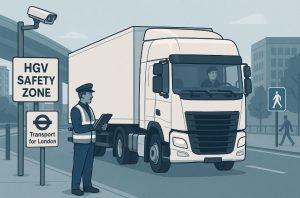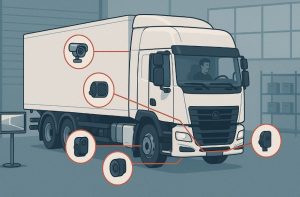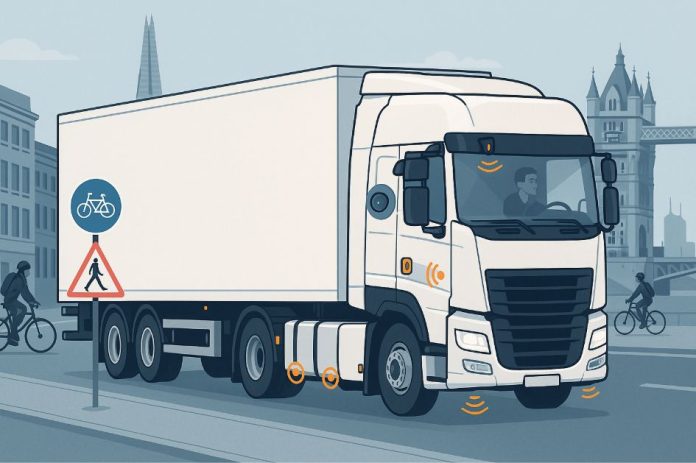Table of Contents
London’s roads are some of the busiest and most complex in the UK. To protect pedestrians, cyclists, and other vulnerable road users, Transport for London (TfL) has introduced strict safety regulations for Heavy Goods Vehicles (HGVs).
These include mandatory compliance with the Direct Vision Standard (DVS) and possession of an HGV safety permit. The consequences for failing to follow these regulations can be severe, with fines reaching up to £550 per vehicle.
This guide outlines how the system works, who it affects, and how to avoid penalties by ensuring full compliance.
What Are the Current HGV Safety Rules Enforced in London?

HGV operators entering or moving within Greater London must comply with TfL’s safety standards. These rules aim to reduce the number of fatal or serious injuries involving lorries, particularly in inner London where space is limited and non-motorised road users are more prevalent.
The Foundation of HGV Safety Regulations
At the core of London’s HGV safety requirements is the Direct Vision Standard, which evaluates how much the driver can see directly through their cab windows.
Unlike traditional mirror systems, DVS focuses on real-time visual perception without the aid of external equipment. The rationale is simple: if a driver can see a pedestrian or cyclist with their own eyes, response times are faster and accidents are more easily avoided.
Legal Mandates for Operating HGVs in London
Every HGV over 12 tonnes gross vehicle weight must hold a valid HGV safety permit issued by TfL. Without it, the vehicle is operating illegally. Enforcement is strict, and fines are issued through camera networks and roadside checks.
Additionally, operators must ensure their vehicles meet specific visibility and safety equipment standards. If the DVS rating of a vehicle is low, they must install what’s called a Safe System a suite of technologies and features designed to compensate for poor direct vision.
Why is the Direct Vision Standard (DVS) critical for HGV drivers in London?
The DVS is more than a technical rating. it is a life-saving framework that directly correlates with public safety. The metric assigns vehicles a star rating from 0 to 5, depending on how much direct vision the driver has through their windows.
Reducing Risks in High-Traffic Areas
In busy urban centres, drivers of large vehicles are often required to make quick judgments in congested conditions.
The more direct visibility a driver has, the more accurately and swiftly they can react to surrounding traffic, pedestrians, and cyclists. A DVS rating reflects this visibility in measurable terms.
Impact on Road Safety Initiatives
The DVS is part of the broader Vision Zero strategy, TfL’s commitment to eliminating all deaths and serious injuries on London’s roads by 2041.
Since its implementation, there has been a measurable decrease in fatal collisions involving HGVs, validating the effectiveness of the system.
How Do Hgv Operators Obtain a London Hgv Safety Permit?
Acquiring an HGV safety permit is a straightforward process, but it does require preparation and adherence to TfL’s requirements.
Assessing the Vehicle’s DVS Rating
Before applying, operators need to know the DVS star rating of their vehicle. This rating is usually available from the manufacturer or the vehicle’s importer. If the vehicle scores 0 to 2 stars, it must be retrofitted with a Safe System to qualify for a permit.
Application Process Through TfL
The application is submitted online via the TfL portal. Applicants must provide vehicle registration details and documentation proving the DVS rating or the installation of the Safe System. Once approved, the permit must be displayed clearly on the vehicle.
As of current regulations, all permits are valid until 28 October 2024, after which new standards will apply.
What Types of Equipment Are Mandatory Under Hgv Safety Regulations?

When a vehicle does not meet the minimum DVS star rating, operators are required to install a Safe System. This system includes several components aimed at improving the driver’s indirect visibility and alerting vulnerable road users to the presence of the vehicle.
Enhanced Visibility Tools
Vehicles must be equipped with Class V mirrors on the nearside and Class VI mirrors at the front to expand the driver’s field of vision. These mirrors reduce blind spots and help monitor pedestrians and cyclists around the vehicle.
Camera Monitoring and Detection Systems
Installation of a camera monitoring system is mandatory for blind spot detection. These cameras must be operational and display a clear view to the driver at all times. Additionally, proximity sensors are required to detect movement alongside the nearside of the HGV.
Warning Systems and Protective Features
To actively protect vulnerable road users, audible warning systems must be installed to alert pedestrians and cyclists when the vehicle is turning left. Side under-run protection must also be fitted to physically prevent people from being caught under the wheels in the event of a collision.
How Much Are the Fines for Non-compliance With Hgv Safety Standards in London?
TfL takes enforcement seriously, and penalties for non-compliance are designed to deter negligence.
Penalty Structure and Timelines
If an HGV enters Greater London without a valid safety permit, the operator is issued a Penalty Charge Notice (PCN) of £550 per offence.
If paid within 14 days, the fine is reduced to £275. However, repeated offences may lead to more severe consequences, including prosecution and impounding of the vehicle.
Common Offences and Missteps
Operators are often penalised for failing to renew expired permits, using fraudulent permits, or neglecting to maintain their safety equipment.
TfL uses ANPR cameras throughout the city to monitor compliance, making it nearly impossible for non-compliant vehicles to go unnoticed.
Who Enforces London’s Hgv Safety Rules and How?
TfL has developed a robust enforcement framework that combines technology, data analysis, and manual inspection.
Role of Technology in Enforcement
Automatic Number Plate Recognition (ANPR) cameras are deployed across the city and integrated with TfL’s compliance database. These systems automatically flag vehicles that either lack a permit or have a permit that has expired or been revoked.
Manual Checks and Audits
In addition to technology, enforcement officers conduct roadside inspections and company audits. These checks verify not only permit validity but also the operational status of safety equipment.
What Steps Can Fleet Operators Take to Stay Compliant and Avoid Fines?

Maintaining compliance is an ongoing process that requires commitment from both fleet managers and drivers.
Routine Vehicle Inspections
Operators should implement daily and weekly inspection protocols to ensure all safety equipment, such as cameras and sensors, are fully functional. Regular servicing should be documented and kept on record for compliance reviews.
Driver Training and Awareness
Drivers must be trained to understand the importance of the DVS, how to use the installed equipment correctly, and how to navigate London’s restricted zones. Periodic refreshers can help reinforce safe driving behaviour.
Use of Digital Compliance Tools
Many companies are now adopting digital platforms to track permit statuses, equipment health, and training records. This ensures nothing slips through the cracks and helps demonstrate proactive compliance in the event of an audit.
How Do These Rules Impact Logistics and Delivery Companies Operating in London?
The HGV safety regulations undoubtedly introduce new operational considerations for businesses.
Increased Operating Costs
The need to install or upgrade equipment, train staff, and manage compliance paperwork can raise short-term costs. Smaller companies, in particular, may feel the burden of these investments.
Operational Adjustments
Delivery routes may need to be altered to avoid penalties, especially during peak enforcement hours. Schedules must also factor in time for safety checks and equipment inspections.
Reputation and Responsibility
However, the upside includes improved safety records, reduced liability, and a stronger brand image. Companies known for safety and compliance are more likely to secure long-term contracts and face fewer disruptions.
What’s the Difference Between the Dvs and Other Clean Air or Congestion Charges?
The DVS is often confused with other London transport schemes, but it serves a different purpose.
| Scheme | Purpose | Applies To | Key Focus Area |
| Direct Vision Standard (DVS) | Improve driver visibility and reduce collisions | HGVs over 12 tonnes | Safety and road user protection |
| Ultra Low Emission Zone (ULEZ) | Reduce air pollution from high-emission vehicles | Most vehicle types entering Greater London | Emissions control and air quality |
| Congestion Charge | Manage traffic levels in central London | All vehicles entering central London | Traffic reduction and road use efficiency |
How is the future of HGV safety regulations in London evolving?
Looking ahead, TfL plans to tighten regulations further.
2024 and Beyond
From 28 October 2024, the minimum DVS rating requirement will rise to three stars. Vehicles that do not meet this threshold must be fitted with the upgraded Progressive Safe System. This includes more advanced features such as automated blind spot detection and enhanced driver alerts.
Long-Term Vision for Road Safety
TfL’s long-term strategy includes expanding the enforcement zones and integrating smarter technology into enforcement. This might include live data sharing from vehicles, real-time compliance alerts, and AI-powered route management tools.
How Can HGV Operators Avoid £550 Penalties Under London’s Safety Rules?

Avoiding hefty fines in London starts with proactive planning and meticulous compliance. The £550 penalty is not simply a fee.
it’s a consequence of failing to meet road safety responsibilities. TfL enforces these standards rigorously, so operators must treat compliance as an essential part of their business operations, not just an administrative task.
Understand the Regulations Fully
Operators must stay informed about the latest requirements under the Direct Vision Standard and HGV Safety Permit Scheme. This includes knowing the vehicle’s DVS rating, understanding what qualifies as a Safe System, and keeping up with TfL’s scheduled updates.
Being unaware of changes such as the upcoming rise in the minimum DVS rating in October 2024 is not considered a valid excuse for non-compliance. Regularly checking the TfL website and subscribing to their operator bulletins can help stay ahead.
Ensure Permit Validity and Visibility
All HGVs over 12 tonnes must display a valid permit when operating within London. The permit must not only be current but also clearly visible on the vehicle. Failure to display a valid permit, even if one has been issued, can still result in a Penalty Charge Notice.
Install and Maintain Approved Equipment
If your vehicle requires a Safe System, it’s crucial that all equipment is not only installed but fully functional. This includes cameras, sensors, audible warning systems, and under-run protection. Regular inspections and maintenance schedules should be part of your operational routine.
Breakdowns or faulty safety systems are treated as non-compliance during inspections. TfL’s enforcement officers won’t hesitate to issue a fine if required equipment isn’t working as intended.
Train Drivers and Fleet Staff
Driver awareness plays a huge role in maintaining compliance. Operators should invest in training programmes that educate drivers on:
- The significance of DVS ratings
- Correct use of safety technology
- Identifying and responding to compliance issues on the road
Well-trained drivers are less likely to make costly errors that lead to fines and are more capable of ensuring daily vehicle checks are performed properly.
Use Fleet Management Tools
Advanced fleet management systems can help track permit statuses, flag upcoming expiries, monitor safety equipment condition, and log inspections. These tools offer real-time insights that allow operators to take action before a violation occurs.
Many modern systems integrate directly with TfL databases or offer API access to regulatory updates, which is invaluable for staying compliant without administrative overload.
Schedule Internal Audits and Reviews
Performing regular internal audits ensures your fleet remains within legal boundaries. This should include:
- Reviewing the permit database for expirations
- Confirming safety systems are operational
- Ensuring drivers are following correct procedures
By identifying risks early, operators can correct issues before they result in a £550 fine or reputational damage.
Conclusion
Complying with London HGV safety rules fines is more than just a legal obligation. it’s a vital component of safe and responsible logistics. With penalties reaching £550 per offence, no operator can afford to ignore these rules.
By staying informed, training staff, upgrading vehicles, and planning strategically, businesses can operate confidently within London while helping to create a safer environment for all road users.
FAQs About London HGV Safety Fines
Do I need a new permit if I upgrade my vehicle?
Yes, if the DVS rating or vehicle configuration changes, you must apply for a new permit.
How do I know if my vehicle meets the minimum DVS requirement?
Contact the manufacturer or check TfL’s DVS checker tool to confirm your vehicle’s rating.
Are rental HGVs subject to the same rules?
Yes, all HGVs entering London, including leased and rented vehicles, must have a valid safety permit.
Can an operator be fined multiple times in a single day?
Yes, if multiple vehicles are non-compliant or if a vehicle re-enters the enforcement zone, additional fines may apply.
Do non-UK registered HGVs need to comply?
Yes, foreign-registered vehicles must also meet DVS requirements and obtain a permit before entering London.
Is financial support available for small fleet upgrades?
TfL periodically offers grants or partnerships; check their official announcements for availability.
What happens if my permit application is rejected?
You will receive reasons for the rejection and instructions on what to correct before reapplying.

